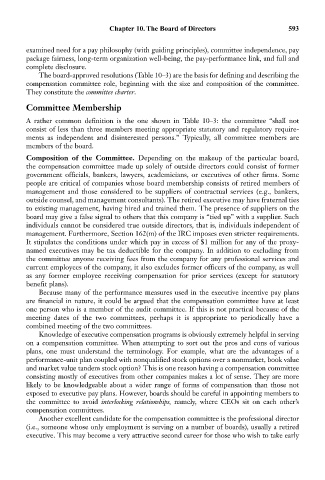Page 607 - Bruce Ellig - The Complete Guide to Executive Compensation (2007)
P. 607
Chapter 10. The Board of Directors 593
examined need for a pay philosophy (with guiding principles), committee independence, pay
package fairness, long-term organization well-being, the pay-performance link, and full and
complete disclosure.
The board-approved resolutions (Table 10–3) are the basis for defining and describing the
compensation committee role, beginning with the size and composition of the committee.
They constitute the committee charter.
Committee Membership
A rather common definition is the one shown in Table 10–3: the committee “shall not
consist of less than three members meeting appropriate statutory and regulatory require-
ments as independent and disinterested persons.” Typically, all committee members are
members of the board.
Composition of the Committee. Depending on the makeup of the particular board,
the compensation committee made up solely of outside directors could consist of former
government officials, bankers, lawyers, academicians, or executives of other firms. Some
people are critical of companies whose board membership consists of retired members of
management and those considered to be suppliers of contractual services (e.g., bankers,
outside counsel, and management consultants). The retired executive may have fraternal ties
to existing management, having hired and trained them. The presence of suppliers on the
board may give a false signal to others that this company is “tied up” with a supplier. Such
individuals cannot be considered true outside directors, that is, individuals independent of
management. Furthermore, Section 162(m) of the IRC imposes even stricter requirements.
It stipulates the conditions under which pay in excess of $1 million for any of the proxy-
named executives may be tax deductible for the company. In addition to excluding from
the committee anyone receiving fees from the company for any professional services and
current employees of the company, it also excludes former officers of the company, as well
as any former employee receiving compensation for prior services (except for statutory
benefit plans).
Because many of the performance measures used in the executive incentive pay plans
are financial in nature, it could be argued that the compensation committee have at least
one person who is a member of the audit committee. If this is not practical because of the
meeting dates of the two committees, perhaps it is appropriate to periodically have a
combined meeting of the two committees.
Knowledge of executive compensation programs is obviously extremely helpful in serving
on a compensation committee. When attempting to sort out the pros and cons of various
plans, one must understand the terminology. For example, what are the advantages of a
performance-unit plan coupled with nonqualified stock options over a nonmarket, book value
and market value tandem stock option? This is one reason having a compensation committee
consisting mostly of executives from other companies makes a lot of sense. They are more
likely to be knowledgeable about a wider range of forms of compensation than those not
exposed to executive pay plans. However, boards should be careful in appointing members to
the committee to avoid interlocking relationships, namely, where CEOs sit on each other’s
compensation committees.
Another excellent candidate for the compensation committee is the professional director
(i.e., someone whose only employment is serving on a number of boards), usually a retired
executive. This may become a very attractive second career for those who wish to take early

